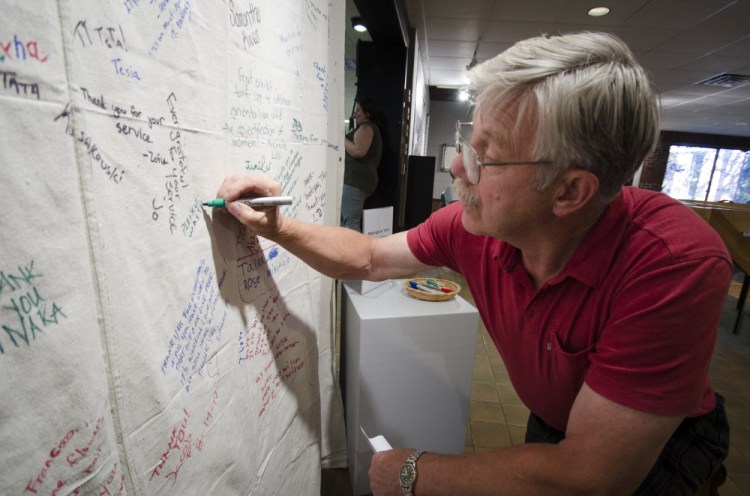Memories return as the Vietnam veterans visit an exhibit about life aboard a Navy transport ship.
AUGUSTA — Memories of extreme heat and cramped conditions came flooding back for dozens of Vietnam-era veterans who visited an exhibit about life aboard a Navy transport ship and were honored during a ceremony at the University of Maine at Augusta’s Danforth Gallery on Thursday night.
The exhibit included a berthing unit from the USS General Nelson M. Walker, with eight canvas bunks attached to a metal frame and old orange lifejackets hanging from each end. The General Walker transported American soldiers and Marines to the Vietnam War from 1966 to 1967, carrying up to 5,000 troops at a time.
“It brings back a lot of memories,” said John Lambert of Alfred, who sailed to Vietnam aboard the General Walker for three weeks in July 1966. “It was extremely hot in the middle of July, and there were 5,000 men on the ship, so it was very crowded. … We also had small duffel bags that we had to fit in our bunks, and we had rifles that we had to sleep with, and there was no air.”

Vietnam War veteran Richard Cook of Fayette is joined by his wife, Joan, on Thursday at the University of Maine at Augusta during a welcome home ceremony for Vietnam veterans.
As an infantryman in the Vietnam War, Lambert, 70, helped patrol the country’s central highlands and the Cambodian border. He was one of about 40 veterans who was honored Thursday night at the ceremony put on by the Maine Bureau of Veterans’ Services.
For the last month, the berthing unit from the troop ship has been displayed alongside other artifacts from the war preserved and compiled into an exhibit called the Vietnam Graffiti Project by Art Beltrone, a historian of military artifacts.
The canvases from other bunks were stretched across the walls of the gallery, providing a clear view of the graffiti that troops had scrawled in black ink.
Some wrote their names, nicknames, ranks and dates of service. They also drew caricatured portraits of the women they met or imagined in foreign countries, with titles like “Sharon Lee: Queen of the South Seas” and “Miss Okinawa ’67.” Other pieces suggested the fever dreams that the troops, possibly seasick, experienced on their way to war, such as a reptilian rodent with its fangs bared, or a fish with a muscular arm sticking out of its body.
The exhibit came to Maine as part of an initiative by former President Obama to honor veterans who served during the Vietnam War, roughly coinciding with the 50-year anniversary of America’s entry into the long conflict.

The Vietnam Graffiti Project at the University of Maine at Augusta features artificates from the USNS General Walker, a ship that transported U.S. troops to Vietnam. This is bunk canvas was created by a soldier named “Patton” while on board.
Of the more than 100,000 veterans living in Maine, about 45,000 served in Vietnam, said Adria Horn, director of the Bureau of Veterans’ Services. Many, Horn said, were not recognized for their service.
Horn, an Army veteran, served in Iraq and Afghanistan and said Vietnam veterans have been some of the biggest supporters of soldiers coming home from those conflicts. But after Vietnam, they “didn’t get the proper recognition,” she said. “To be spit on, to be ashamed to wear a uniform, they struggled so my generation didn’t have to. … You didn’t get the welcome home you deserved.”
Horn presented pins, certificates and commemorative coins to the Vietnam veterans.
“It’s been a long time coming,” said one veteran, Fernando Paradis of Waterville, after Horn presented the items. “I want to say: Greatly, greatly appreciate it, on behalf of all of us. Thank you.”
Two other men at the ceremony also sailed on the General Walker. One of them, Al Sabaka of Bridgton, has met the historian who made the exhibit and helped bring it to Maine.
The other, Hank Deshane, 73, also recalled the claustrophobia he felt while on the ship in October 1967, but described himself as relatively lucky. Unlike other soldiers, he had a bottom bunk, meaning he could roll onto the cooler tile floor when the quarters got too hot. And his berth was high enough in the ship that it had a porthole, so he could glimpse outside.
During the war, Deshane helped maintain Army Chinook helicopters, but on the three-week trip from Oakland, California, none of the troops knew what to expect. “We didn’t even know where we were going,” he said.
Ironically, perhaps, it was the well-informed, English-language broadcasts of Hanoi Hannah, a Vietnamese radio personality, that informed the men where their units were headed.
“It was saying, ‘Welcome to Vietnam. We’re waiting for you,'” Deshane recalled of her show, which the troops picked up on their own radios. While her intelligence turned out to be correct, he continued, “We all laughed at it, because we knew it was propaganda.”
Charles Eichacker can be contacted at 621-5642 or at:
ceichacker@centralmaine.com
Twitter: @ceichacker
Copy the Story LinkSend questions/comments to the editors.




Success. Please wait for the page to reload. If the page does not reload within 5 seconds, please refresh the page.
Enter your email and password to access comments.
Hi, to comment on stories you must . This profile is in addition to your subscription and website login.
Already have a commenting profile? .
Invalid username/password.
Please check your email to confirm and complete your registration.
Only subscribers are eligible to post comments. Please subscribe or login first for digital access. Here’s why.
Use the form below to reset your password. When you've submitted your account email, we will send an email with a reset code.